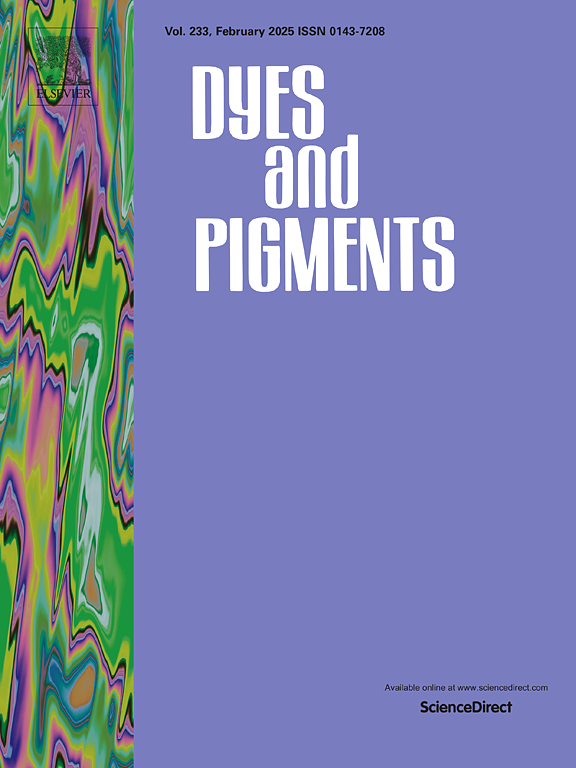Synthesis and photophysical properties of π-extended carboxyl BODIPYs: An experimental and theoretical study
IF 4.1
3区 工程技术
Q2 CHEMISTRY, APPLIED
引用次数: 0
Abstract
A series of new boron-dipyrromethenes (BODIPYs) bearing 4-carboxyphenyl unit at the meso (8) position of the BODIPY core have been successfully synthesized through the reactions of 2,4-diaryl substituted pyrroles with 4-formylbenzoic acid. The palladium-catalyzed Suzuki-Miyaura coupling reactions were performed on the meso unsubstituted BODIPY derivatives with 4-carboxyphenyl boronic acid to obtain distal and proximal substitution. Chemical structures were characterized using high resolution mass spectrometry (HRMS), 1H/13C NMR, and FTIR spectroscopy. The photophysical properties, excited state dynamics, and thermal degradation profiles were investigated in terms of aromatic subunits using electronic absorption/fluorescence measurements, femtosecond transient absorption spectroscopy, and thermogravimetric analysis (TGA), respectively. Experimentally investigated absorption and fluorescence properties, as well as structural features, were clarified using density functional theory (DFT) and electron-hole analysis. The absorption of the compounds ranges from 504 to 594 nm, and their emission ranges from 609 to 640 nm, depending on the aromatic groups at the BODIPY core. Performed pump probe spectroscopy measurements revealed that the excited state lifetime is shortened for 3,5 (proximal) positions compared to 1,7 (distal) positions due to increasing interactions between the molecular orbitals. The local n–π and π-π∗ excitations from DFT calculations and electron-hole analysis mainly characterize the electronic transitions, leading to limited intramolecular charge transfer to the BODIPY core. Charge transfer is highest at the 3,5-positions, decreases at the meso (8) position, and is lowest at the 1,7-positions of the BODIPY core. The newly developed BODIPYs with carboxyl groups show potential as agents in applications demanding extensive absorption and strong emission characteristics.

π-扩展羧基体dipys的合成及其光物理性质的实验与理论研究
通过2,4-二芳基取代吡咯与4-甲酰苯甲酸的反应,成功合成了一系列在BODIPY核心中位(8)上含有4-羧基苯基单元的新型硼二吡咯(bodipyys)。在钯催化下,4-羧基苯基硼酸对未取代的介观BODIPY衍生物进行了Suzuki-Miyaura偶联反应,得到了远端和近端取代。化学结构采用高分辨率质谱(HRMS)、1H/13C NMR和FTIR光谱进行表征。利用电子吸收/荧光测量、飞秒瞬态吸收光谱和热重分析(TGA)分别研究了芳香族亚基的光物理性质、激发态动力学和热降解谱。利用密度泛函理论(DFT)和电子空穴分析澄清了实验研究的吸收和荧光性质以及结构特征。化合物的吸收范围为504 ~ 594 nm,发射范围为609 ~ 640 nm,这取决于BODIPY核心的芳香族基团。泵浦探针光谱测量表明,由于分子轨道之间的相互作用增加,3,5个(近端)位置的激发态寿命比1,7个(远端)位置缩短。DFT计算和电子空穴分析的局部n -π和π-π *激发主要表征电子跃迁,导致有限的分子内电荷转移到BODIPY核心。BODIPY核的电荷转移在3,5位处最高,在介观(8)位处降低,在1,7位处最低。新开发的具有羧基的BODIPYs在需要广泛吸收和强发射特性的应用中显示出潜力。
本文章由计算机程序翻译,如有差异,请以英文原文为准。
求助全文
约1分钟内获得全文
求助全文
来源期刊

Dyes and Pigments
工程技术-材料科学:纺织
CiteScore
8.20
自引率
13.30%
发文量
933
审稿时长
33 days
期刊介绍:
Dyes and Pigments covers the scientific and technical aspects of the chemistry and physics of dyes, pigments and their intermediates. Emphasis is placed on the properties of the colouring matters themselves rather than on their applications or the system in which they may be applied.
Thus the journal accepts research and review papers on the synthesis of dyes, pigments and intermediates, their physical or chemical properties, e.g. spectroscopic, surface, solution or solid state characteristics, the physical aspects of their preparation, e.g. precipitation, nucleation and growth, crystal formation, liquid crystalline characteristics, their photochemical, ecological or biological properties and the relationship between colour and chemical constitution. However, papers are considered which deal with the more fundamental aspects of colourant application and of the interactions of colourants with substrates or media.
The journal will interest a wide variety of workers in a range of disciplines whose work involves dyes, pigments and their intermediates, and provides a platform for investigators with common interests but diverse fields of activity such as cosmetics, reprographics, dye and pigment synthesis, medical research, polymers, etc.
 求助内容:
求助内容: 应助结果提醒方式:
应助结果提醒方式:


